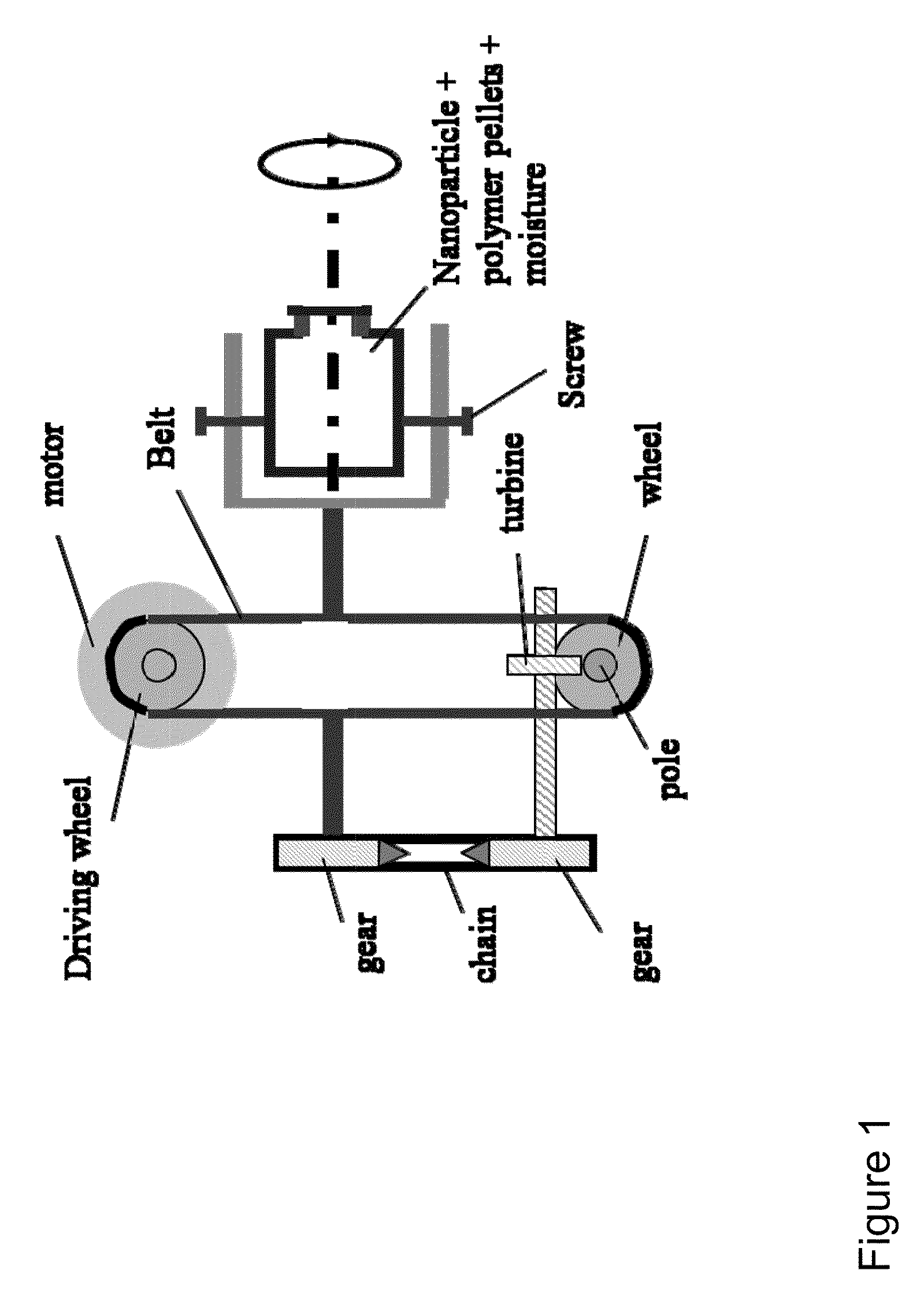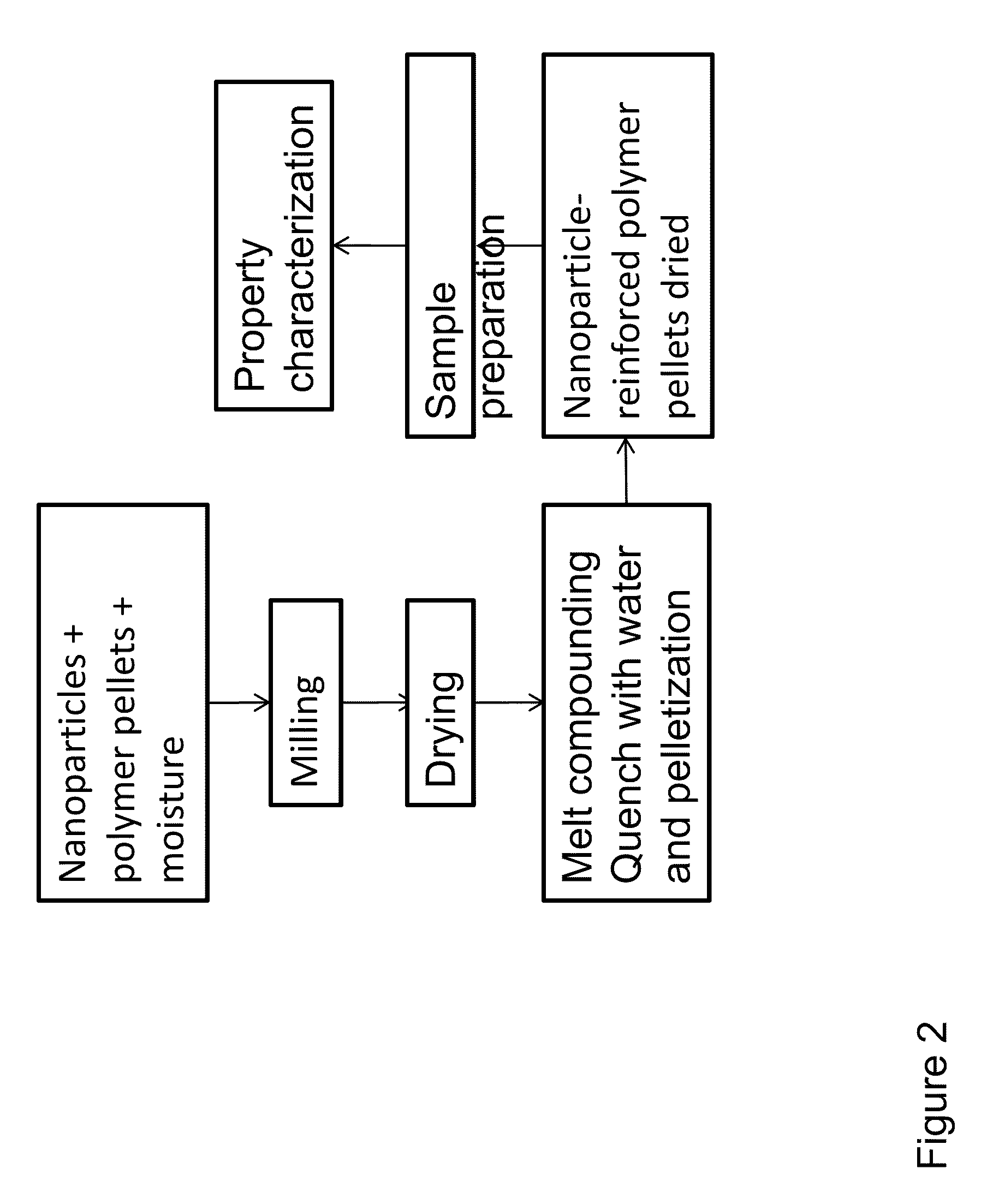Method for making reinforced polymer matrix composites
a polymer matrix and composite technology, applied in the direction of conductive materials, tyre parts, non-conductive materials with dispersed conductive materials, etc., can solve the problems of in-situ polymerization, not proven to be an acceptable manufacturing process for polymer production, and the dispersion of nanoparticles in the polymer matrix
- Summary
- Abstract
- Description
- Claims
- Application Information
AI Technical Summary
Benefits of technology
Problems solved by technology
Method used
Image
Examples
case 1
[0022] Nylon 6 / Multiwall Carbon Nanotube (MWNT) Nanocomposites
[0023]Nylon 6 pellets, such as commercially available from UBE Co., Japan (product name: SF1018A) were utilized. The carbon nanotubes used in this case were MWNTs (such as commercially available from Bayer MaterialScience, product name—Baytubes, grade—C 150P). The average diameter of the MWNTs was approximately 13 nanometers (nm) with a length of 5-20 μm (micrometers or microns).
[0024]Referring to FIG. 2, in step 201, both MWNTs and nylon 6 pellets were dried in a vacuum oven at 80° C. for approximately 16 hours to eliminate any moisture. Then they were inserted in a glass container to go through the milling process. In this case, 0.4 wt. % CNTs were used in a nylon 6 matrix. The mixture of MWNTs (1.82 g (grams)) and nylon 6 (454 g) pellets was ground at 60 rev / min (revolutions per minute) for approximately 6 hours. The MWNTs were then coated onto the surfaces of the nylon 6 pellets. Portions of the MWNTs were coated onto...
case 2
[0042] Nylon 6 / Multiwall Carbon Nanotube (MWNT) Nanocomposites at Higher Loading of the MWNTs.
[0043]A first mixture of the MWNTs and nylon 6 was processed through the milling process at a MWNT loading of 3 wt. % (14.25 g MWNTs with 454 g nylon 6 pellets). 454 g nylon 6 pellets and 14.25 g MWNTs were added into a glass container (so the content of the MWNTs in the mixture is 3 wt. %). The mixture was ground using a tumbler at a speed of 50 rev / min for 6 hours. FIG. 4 shows a digital photograph of the mixture after the ground process. It can be seen that the majority of the MWNTs were not coated onto the surfaces of the nylon 6 pellets. The loading of the MWNTs coated onto the surfaces of the nylon 6 pellets was around 0.2 wt. %, which was weighed calculated after the separated MWNTs were removed.
[0044]A second mixture of 454 g nylon 6 pellets and 14.25 g MWNTs was added into a glass container. 10 ml of ionized water was also added to the container. The mixture was ground using the tu...
case 3
[0050] Nylon 6 / Double Wall Carbon Nanotube (DWNT) Nanocomposites
[0051]The DWNTs were commercially obtained from Nanocyl, Inc., Belgium. These DWNTs were purified and had an average diameter of 2-5 nm at a length of 5-20 μm.
[0052]The following mixtures were run through the milling process:[0053]1. DWNT (0.4 wt. %)+nylon 6 pellets (1.82 g DWNTs+454 g nylon 6 pellets);[0054]2. DWNTs (1.0 wt. %)+nylon 6 pellets (4.59 g DWNTs+454 g nylon 6 pellets);[0055]3. DWNTs (1.0 wt. %)+nylon 6 pellets+water (4.59 g DWNTs+454 g nylon 6 pellets+5 ml water).
[0056]The first mixture of DWNTs (1.82 g) and nylon 6 (454 g) pellets were put in a glass container and ground at 60 rev / min for approximately 6 hours (the loading of the DWNTs was 0.4 wt. %). The DWNTs coated the surfaces of the nylon 6 pellets. No separation between the DWNTs and the nylon 6 pellets was observed. In case 1 mentioned above, the MWNTs at a loading of 0.4 wt. % were not fully coated onto the surfaces of the nylon 6 pellets; since th...
PUM
| Property | Measurement | Unit |
|---|---|---|
| size | aaaaa | aaaaa |
| water absorption rate | aaaaa | aaaaa |
| length | aaaaa | aaaaa |
Abstract
Description
Claims
Application Information
 Login to View More
Login to View More - R&D
- Intellectual Property
- Life Sciences
- Materials
- Tech Scout
- Unparalleled Data Quality
- Higher Quality Content
- 60% Fewer Hallucinations
Browse by: Latest US Patents, China's latest patents, Technical Efficacy Thesaurus, Application Domain, Technology Topic, Popular Technical Reports.
© 2025 PatSnap. All rights reserved.Legal|Privacy policy|Modern Slavery Act Transparency Statement|Sitemap|About US| Contact US: help@patsnap.com



